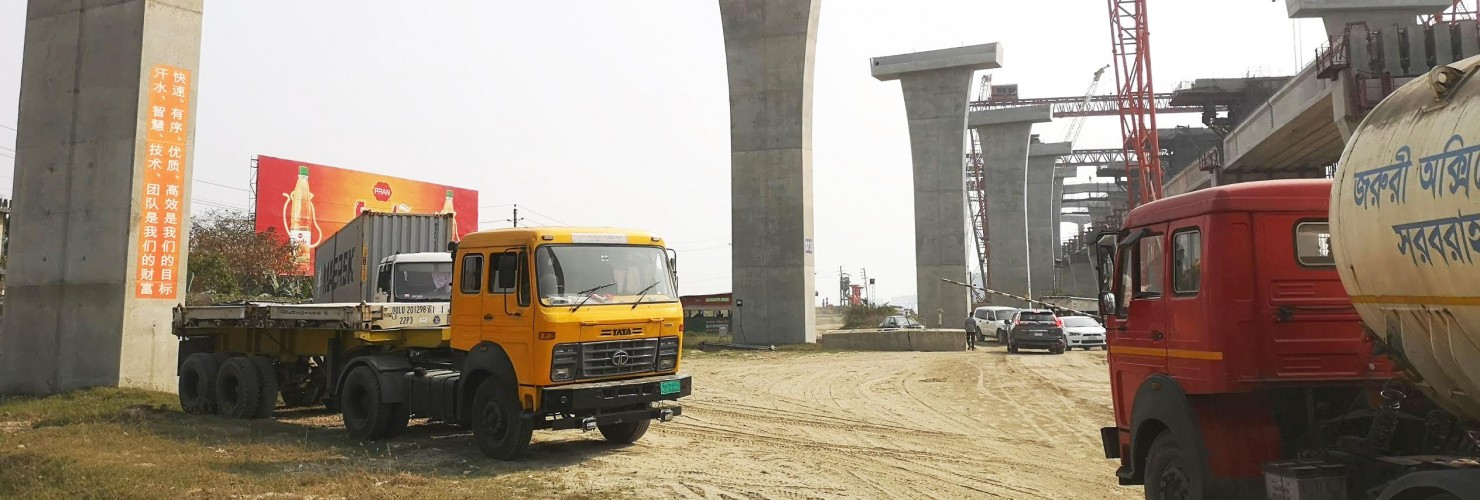

The BRI in Bangladesh: Walking the tightrope between Beijing and Delhi
For smaller powers like Bangladesh, China’s Belt and Road Initiative (BRI) represents an opportunity to fill the infrastructure gap. Beijing is seen as a counterbalance to New Delhi. But for Dhaka, walking that tightrope between giants is not easy, found Jacob Mardell who visited Bangladesh earlier this year when he was traveling along the Belt and Road.
Bangladesh is boxed in on three sides by one of the world’s longest land borders and shares 54 rivers with its colossal neighbor India. Unsurprisingly, the majority of Dhaka’s strategic computing power is occupied by thoughts of Delhi, and it is impossible to talk of China-Bangladesh relations without first mentioning India.
There would be no Bangladesh without “big brother” India helping to establish the independent state in 1971, but like many junior partners in such a close asymmetric relationship, Bangladesh resents its elder sibling’s interference and perceived condescension. Disputes over shared water resources and problems along the border feed divisions, and the aggressive Hindu nationalism of Indian Prime Minister Narendra Modi has further eroded sympathies among Bangladesh’s Muslim majority.
Farooq Sobhan is a veteran diplomat and former Foreign Secretary who served as Ambassador to both India and China. “There is resentment with India,” he tells me, “but with China, we just don’t have any of those pressing bilateral problems that find their way into the media.”
China is seen as a counterbalance to India
While feelings toward India are complex, the public views China as a neutral, if not benign force. “We’re not fond of China per se, but we’re fond of them as a counterbalance to India,” one academic tells me. Another puts it more colorfully - “we are India’s favorite punching bag, and China is seen as our possible savior.”
Although Beijing originally vetoed Bangladesh’s application for UN membership in 1972, Dhaka’s Cold War alignments shifted as it reordered its strategic priorities. According to Sobhan, “the whole idea at that time was to build up our defense forces to stand up against India, and the only country that was willing to help us was China.” Geo-economic realities demanded a forgiving approach to Beijing’s past position on independence, and post-1976 China went all out in courting Bangladesh, providing ample military aid and equipment.
Defense cooperation and weapon deals remain important, but the Sino-Bangladeshi relationship has evolved with China’s emergence as an economic juggernaut. For at least a decade, Bangladesh has been dealing with a “totally transformed China,” as Sobhan puts it, “a quasi super power with deep pockets.” Like many of China’s enthusiastic Belt and Road partners, Bangladesh is attracted by the financial largesse that appears to stand behind the initiative.
Bangladesh suffers from a growth debilitating deficit in infrastructure and China is considered indispensable to plugging this gap. As Shafqat Munir of the Bangladesh Institute of Peace and Security Studies tells me, “we have significant infrastructural needs - if we don’t take a highway from China, who else will provide it?”
Bangladesh is home to the world’s largest delta - it is the land of rivers, a country of constantly shifting land and waters, where boats or seaplanes are sometimes the only option. The journey from Dhaka to the South of the country is broken by river crossings. Heading South to Barisal, you have to stop at Mawa, where a colossal, dusty bus park and frenetic bazar lend the ferry terminal a frontier feeling. “When the bridge is built, the ferries will stop,” my rickshaw driver tells me. He is referring to the great Padma bridge - a massive infrastructure project that will make ferries obsolete.
Beijing steps into vacuums left by traditional donors
Beijing likes building “friendship bridges” - they are symbolic and useful and nowhere more so than in Bangladesh, a country carved into a thousand pieces by mighty and erratic rivers. Seven Bangladesh-China bridges have been completed, and although Padma Bridge is not technically one of them, it is being constructed by a Chinese company and with a loan from China’s Exim Bank.
Padma bridge was originally meant to be funded by the World Bank and other donors. Amid unproven allegations of corruption, the World Bank pulled out, and Dhaka decided to build the bridge with its own funds. As one Dhaka elite tells it: “this demonstrated to the World Bank and the world at large that we’re not beggars anymore.”
Although largely motivated by economic gain, this habit of stepping into vacuums left by traditional donors fuels a narrative that pitches “Western” finance against the Chinese model. In many countries, not just Bangladesh, this model is perceived as more sensitive to local needs and is thought to come with fewer lectures on prudent economic policy and human rights.
However, China will never replace India’s role in South Asia. Geography is inescapable, and Delhi is the true kingmaker in Bangladesh and Nepal. As geo-economic expert Dr. Parvez Karim Abassi tells me, “we’re India-locked, and you just can’t pick a fight with a neighbor that big.” He cites the Indian export ban on onions, which shot food prices through the roof, as an example of the outsized potential effect India has on Bangladeshi life.
Ultimately, Beijing knows this. India is where “debt trap” allegations originated and paranoia is deeply ingrained into Indian thinking about the BRI. But Beijing is sensitive to India’s fears, and more importantly, Bangladesh and Nepal are also acutely aware of India’s insecurities and the dangers of antagonizing Delhi.
It is no secret that Delhi fears Chinese expansion in the Indian Ocean. Beijing’s designs on Bangladeshi ports on the Bay of Bengal are an especially pressing concern and China’s initial interest in building a much-needed new deep seaport port in Northeastern Bangladesh was quashed by unofficial Indian and US protest.
As a solution, Dhaka came up with the idea of building a port at Sonadia with multiple international interests. Partly due to environmental concerns, and possibly due to further geopolitical caution and wariness of Chinese credit, Sonadia didn’t work out either. In the end, the government opted for a Japan-backed port at Matabari, with China receiving a deep seaport project at Payra as an apparent consolation prize. Still, a chorus of protest went up at the possibility of China using Payra as another toehold in the Indian Ocean.
Visiting Payra port on a hazy, stifling day in March, I find little evidence of Chinese adventurism. The journey from Dhaka involves a haulking, overcrowded river boat that arrives in Barisal through the pink mist and black silhouettes of fishermen on the mud-flattened riverbanks. The port is in its early stages, and there is not much to see. “I’d rather go slowly, and then develop with commercial loans when we’re in a comfortable position,” the commodore tells me. Commodore Jahangir Alam is in charge of developing the port. Less a Beijing directed operation, Payra appears to be about providing a focal point of economic activity in the underdeveloped South. It uses government funds, and although Chinese contractors may be involved, tenders have so far gone to European companies.
Beijing’s interest in Bangladesh is less intense than is feared in Delhi
Off the record, a senior official at the port tells me, “we actually expected Chinese finance, but we didn’t get it. Nowadays it’s more difficult to get Chinese finance.” Now it has Kyaukpyu port in Myanmar, Beijing has less need for a port on the Bay of Bengal, especially one so close to India. A relative paucity of funds in the era of BRI 2.0, as well as a wariness of causing unnecessary friction with the US and India, means Beijing’s interest in Bangladesh is less intense than is feared in Delhi.
For smaller powers like Bangladesh, the BRI represents an opportunity to find balance in regional dynamics. Beijing provides much needed capital, and the jealous competitive urges of other great powers can also be cashed in on.
But playing both sides requires skill, and walking that tightrope between giants is not easy. Across the BRI, policymakers and commentators talk about “balance” with grave concern. In the jostling between great powers, the agency of countries stuck in between is often overlooked, but the nuances of great power competition are rarely lost on those in-betweens most keenly affected.
